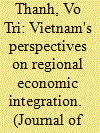|
|
|
Sort Order |
|
|
|
Items / Page
|
|
|
|
|
|
|
| Srl | Item |
| 1 |
ID:
133193


|
|
|
|
|
| Publication |
2014.
|
| Summary/Abstract |
This study uses a theoretically justified gravity model of trade to examine the impact of the ASEAN-China Free Trade Agreement (ACFTA) on exports, focusing on trade creation and diversion effects. The model is tested on a sample of 31 countries over the period dating from 1995 to 2010 using aggregated and disaggregated export data for agricultural and manufactured goods and within manufactures for chemical products, as well as for machinery and transport equipment. In order to obtain unbiased estimates, multilateral resistance terms are included as regressors and the endogeneity bias of the FTA variables is addressed by controlling for the unobserved specific heterogeneity that is specific to each trade flow. A multinomial PML is also applied to solve the zero trade issue and the presence of heteroskedasticity. The results indicate that ACFTA leads to substantial and significant trade creation. Using disaggregated data, the significant and positive relationship between exports and ACFTA is confirmed in the case of both agricultural and manufactured goods, as well as in the case of the most important manufacturing industries, namely, chemical products and machinery and transport equipment.
|
|
|
|
|
|
|
|
|
|
|
|
|
|
|
|
| 2 |
ID:
165372


|
|
|
|
|
| Summary/Abstract |
The present study endeavours to observe the trade creation and trade diversion effects of three free trade agreements (FTAs) in Asia, namely, India–Japan CEPA (IJCEPA), India–Sri Lanka FTA (ISFTA), and India–Bhutan FTA (IBFTA). The article aims to evaluate three uncommon FTAs that include developing–developed, developing–developing and developing–least developed countries. The objective is to evaluate the effects of these FTAs on exports and draw lessons for both the contracting parties and for other economies to commence FTAs that promote trade liberalization. This paper also aims to debunk the myth that FTAs between developing-least developed countries is not beneficial for the developing or least developed counterpart. The study applies augmented gravity model to capture the trade creation and trade diversion effects. The results confirm that ISFTA and IBFTA have trade creation effect, while in case of IJCEPA, there is trade diversion. These bilateral agreements can open the ways for multilateral trade liberalization in the long-run.
|
|
|
|
|
|
|
|
|
|
|
|
|
|
|
|
| 3 |
ID:
153054


|
|
|
|
|
| Summary/Abstract |
Over the past three decades, we have seen a dramatic increase in the incidence of temporary trade barriers such as antidumping duties and countervailing duties. China has been at the receiving end of a large number of such measures. In this paper, we study how China's exports to its major trade partners have been affected when its major trade partners have used these measures either against China or against other countries. We find that Chinese exports to the country that imposed an antidumping duty decreased by approximately 35 percent. At the same time, an antidumping duty used by the importing country that was directed towards other countries but not against China led to an approximate 30-percent increase in China's exports to the policy-imposing country. These results remain robust across various specifications. Our findings have important policy implications. In particular, the magnitude of these effects highlights why it is important to curb the recent widespread use of these barriers.
|
|
|
|
|
|
|
|
|
|
|
|
|
|
|
|
| 4 |
ID:
138139


|
|
|
|
|
| Summary/Abstract |
This paper revisits Vietnamese perspectives on regional economic integration. Proactive economic integration has been an important pillar of Vietnam’s economic reforms. The country’s current economic integration process involves preparation for the ASEAN Economic Community (AEC) and the negotiation of ambitious free trade agreements such as the Trans-Pacific Partnership (TPP) and Regional Comprehensive Economic Partnership (RCEP) agreements. As the umbrella organization for Vietnam’s economic integration, ASEAN continues to forge the country’s trade and investment linkages with the region. The AEC is making progress, but certain challenges remain with the overall management of regional cooperation, improvements to ASEAN centrality and connectivity, and issues related to contemporary regional and non-traditional security. RCEP and TPP represent recent ambitious efforts to promote economic integration. Notwithstanding their potential benefits, RCEP and TPP may produce different outcomes, including trade diversion, for major economies. These two trade agreements have various similarities and differences, but they exhibit potential consistency with the concept of a Free Trade Area of the Asia Pacific. Vietnam’s economy may benefit immensely from ongoing integration efforts. Still, such benefits are conditional on relevant and timely domestic reforms, particularly of economic institutions, state-owned enterprises and public investment. The harmonization of commitments under various economic integration tracks and improvements to market confidence is also critical.
|
|
|
|
|
|
|
|
|
|
|
|
|
|
|
|
|
|
|
|
|